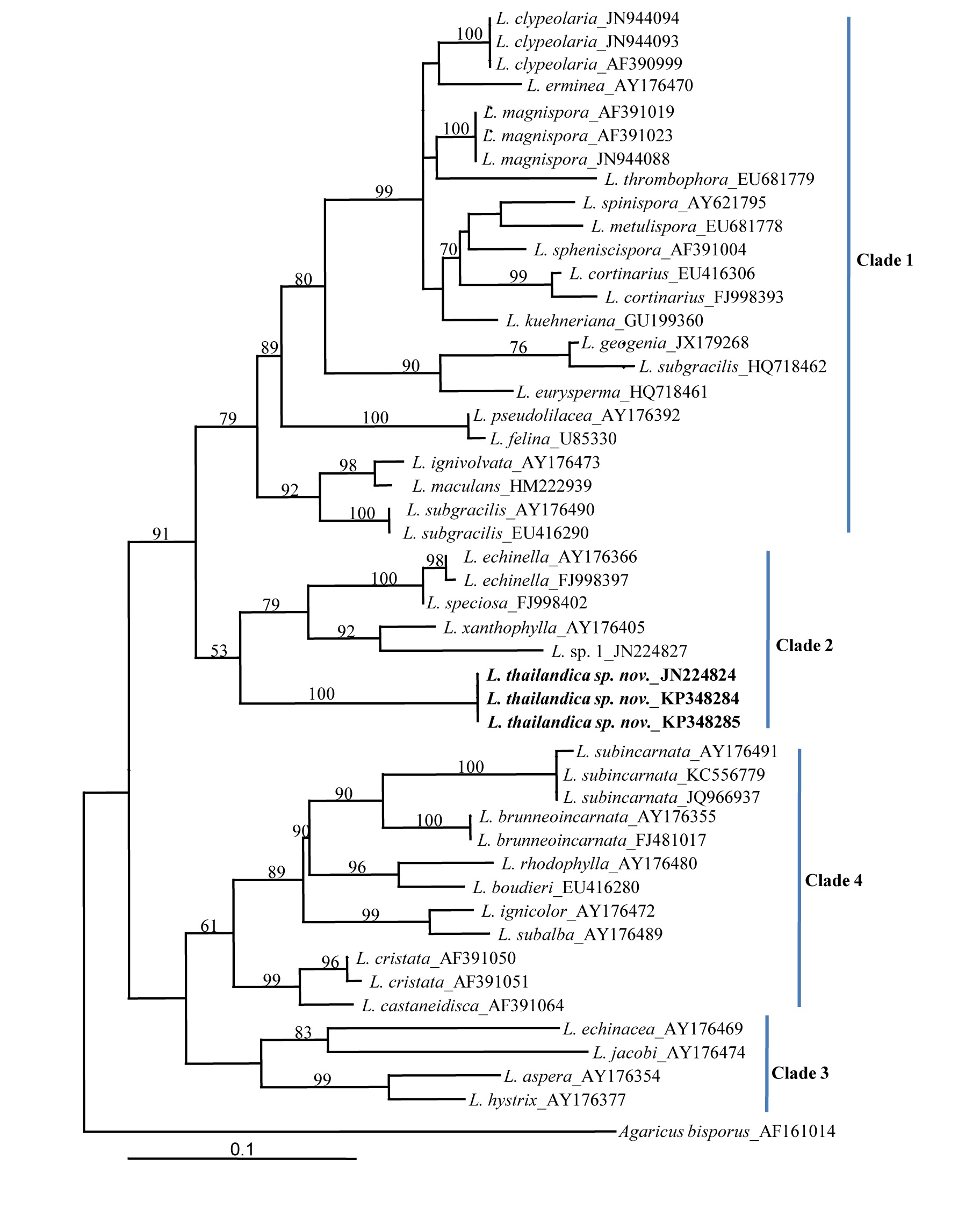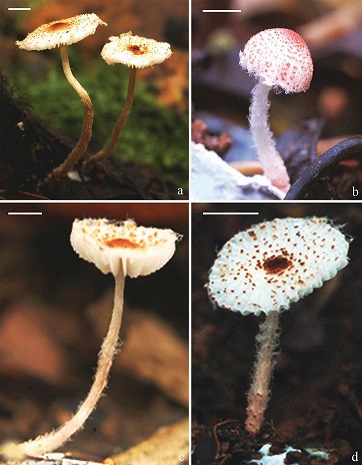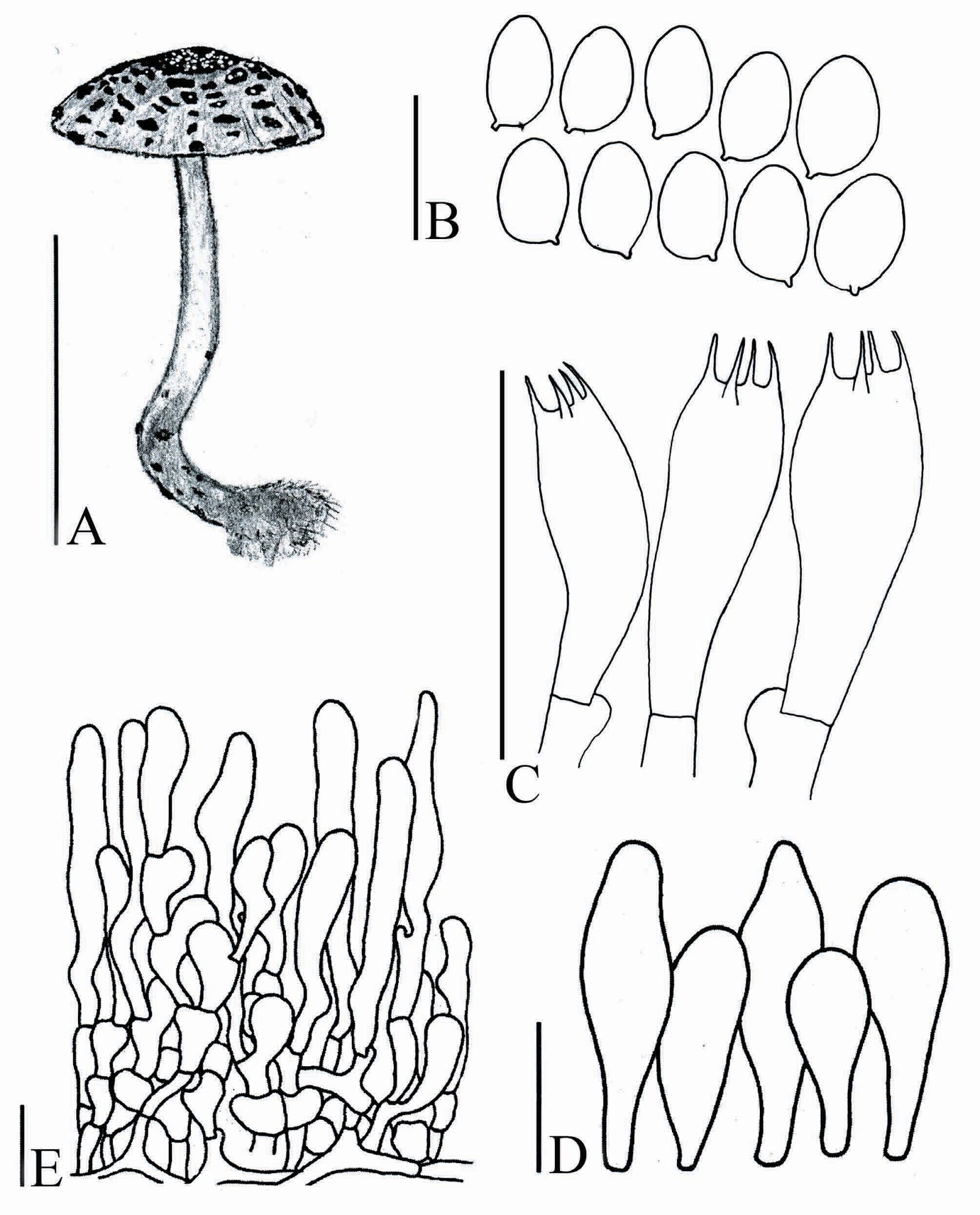Lepiota thailandica Sysouphanthong, K.D. Hyde, J.C. Xu & Mortimer
MycoBank: MB 811224 Holotype: MFLU 09-0120 Facesoffungi number: FoF 01760
Etymology: the species epithet ‘thailandica’ is derived from the name of the country where the type material was collected.
Diagnosis: the new species is characteristic by having tiny basidiomata, reddish brown to brownish orange squamules on the pileus, a cylindrical and white floccose stipe basally covered with squamules concolourous with those on the pileus, oblong ovoid 5.5–6.8 × 3.5–4.2 μm size basidiospores, clavate to utriform 13.5–25 × 5.5–9.5 μm size cheilocystidia, a trichodermal pileus covering made up of cylindrical and short clavate elements, and with presence of clamp-connections in all tissues.
Original description: Pileus 3–4 mm, at first subglobose to parabolic, expanding to broadly convex, convex, or umbonate with low or high umbo, often applanate to plano-concave when fully mature, with straight margin; when young completely reddish brown to brownish orange (7B7-8, 7C6-8), glabrous or slightly rough, later surface breaking and leaving concolourous glabrous region at the centre of the umbo, with irregular concolourous squamules around umbo towards margin on white fibrillose background; margin sulcate or striate when mature, with concolourous squamules and white floccose or cortinate remnants, fringed and with remnants exceeding the lamellae. Lamellae free, moderate or slightly crowded, broadly ventricose, up to 1 mm wide, white, with concolourous eroded edge. Stipe 7–13 × 0.5–1.5 mm, cylindrical, or slightly tapering to the apex; surface white to yellowish white (4A2), white fibrillose or floccose, at the basal zone covered with squamules concolourous with those on the pileus. Context white and thin in pileus, up to 0.5 mm wide; white and hollow in the stipe. Taste and smell not observed. Spore print white.
Microscopical characters: Basidiospores [75,4,3] 5.5–6.8 × 3.5–4.2 μm, avl × avw = 6.1 × 3.8 μm, Q = 1.5–1.7 μm, Qav = 1.6, in side-view ellipsoid to oblong ovoid, in frontal view oblong to fusiform, hyaline, thick-walled, dextrinoid, congophilous, cyanophilous, not metachromatic. Basidia 15–17 × 6–7 μm, clavate, thin-walled, 4-spored. Lamella edge sterile, with crowded cheilocystidia. Cheilocystidia 13.5–25 × 5.5–9.5 μm, clavate to broadly clavate, sometimes utriform or fusiform, hyaline, thin-walled. Pleurocystidia absent. Pileus covering trichodermal, made up of two layers of elements; upper layer made up of cylindrical to narrowly cylindrical elements, normally with rounded apex, rarely with tapered apex, 55–95 × 5.5–22 μm; lower layer made up of shortly clavate to irregularly clavate elements, 20–40 × 5–15 μm; all elements with pale brown parietal pigment, thick-walled. Clamp-connections present in all tissues.
Habitat and distribution: solitary or in small groups with few basidiomata, saprotrophic, on decayed leaves and wood; widespread in high elevation deciduous forests of northern Thailand.
Material examined: THAILAND. Chiang Mai Province: Mae Taeng district, Mae Sae village, N 19° 14.59’, E 98° 39.45’, 962 m, 05 July 2008, P. Sysouphanthong PS047 (MFLU 09-0120, holotype); Chiang Mai Province: Mae Taeng district, Pha Deng village, N 19° 07.13’, E 98° 43.52’, 905 m, 10 July 2008, P. Sysouphanthong PS053 (MFLU 09-0126, paratype); Chiang Rai Province: Vieng Xieng Rung district, Hui Mae Sack waterfall, 23 September 2009, P. Sysouphanthong PHO026 (MFLU 10-0516, paratype).



